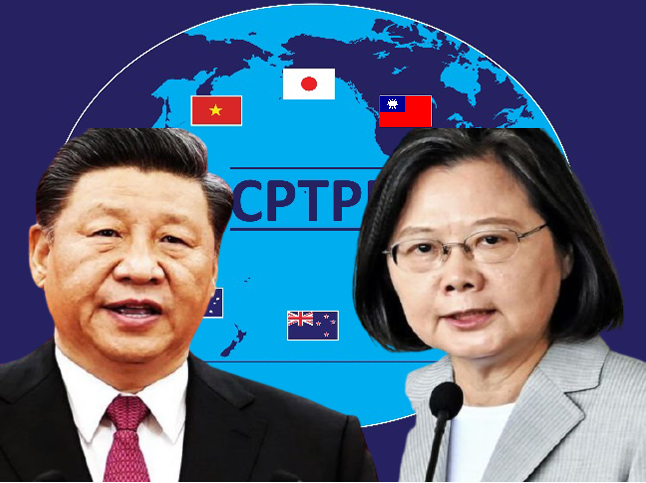
- Taiwan is planning to join CPTPP as its member countries account for over 24% of Taiwan’s international trade.
- Joining the group would be seen as a major political victory for President Tsai, whose government views Taiwan as a de facto sovereign nation awaiting broader international recognition.
- China wants to contain Taiwan and wants to take over it as part of its territory and vehemently opposes any moves that imply separate statehood for Taiwan, such as joining international organizations.
- China wants to pressurise Taiwan by tying down the island’s naval defenses and undermining their livelihoods. It wants to target Taiwan recognition in the world and also block its international membership in different organizations.
Comprehensive and Progressive Agreement for Trans-Pacific Partnership is a $13.5 trillion trade agreement planned by Western-led alliance to counterbalance China’s economic might in the Pacific region. It has 11 Members like Australia, Brunei, Canada, Chile, Japan, Malaysia, Mexico, New Zealand, Peru, Singapore and Vietnam. CPTPP countries signed a trade pact in March 2018 and is home to around 500 million people and generates more than 13% of the world’s income. The advantage for the member countries is greater access to each other’s markets, pledge to eliminate or reduce 95% of import charges or tariffs and expand supply chains across the constituent countries and same treatment as domestic firms when member countries put money into the projects.
Though the US spearheaded CPTPP, it withdrew in 2017 and Japan assumed a key role in reviving it. When CPTPP was going smoothly China applied for membership by targeting Taiwan’s Membership. As both Nations have historical and diplomatic recognition, tensions accepting their application by New Zealand’s government which handles the paperwork has become a challenge if they have to admit one or neither.
Taiwan already has free-trade deals with two of the members New Zealand and Singapore. Taiwan is planning to join CPTPP as its member countries account for over 24% of Taiwan’s international trade. Taiwan President Tsai Ing-wen urged Japan to support her government’s efforts to join the deal adding that her government has been preparing to join for the past five years and is prepared to accept all the rules. Japan welcomed Taiwan’s bid and would respond “based on a strategic point of view and with the public’s understanding.” Joining the group would be seen as a major political victory for President Tsai, whose government views Taiwan as a de facto sovereign nation awaiting broader international recognition.
China wants to contain Taiwan and wants to take over it as part of its territory and vehemently opposes any moves that imply separate statehood for Taiwan, such as joining international organizations. It advocates “One-China principle” and forces other nations to accept its views on foreign policy. So China is pitching itself for the membership and once it enters CPTPP it will make sure Taiwan is not there. Another view is that China aims to keep the US from joining and delay the CPTPP’s expansion into a larger-scale framework. For China CPTPP has a political as well as an economic. objective.
Politically, it aims to present a bloc with a common front and economy to create new rules countering China’s practices of disrupting global trade norms, including its subsidies to state enterprises. Japan Foreign Minister Toshimitsu Motegi said Japan would have to look properly at whether China was “ready to reach the high level of TPP.” Australia also reacted cautiously to China’s application, noting that any applicant would need “a track record of compliance with its commitments in the WTO and existing trade agreements,” according to a statement from Trade Minister Dan Tehan. Australia is currently suing China at the World Trade Organization over tariffs on barley and wine.
Taiwan’s chief trade negotiator John Deng said “China always obstructs Taiwan’s room to maneuver on the international stage. This is something everyone is aware of. So if China is able to join first, it’s clear that Taiwan’s application will be at risk.” Taiwan and China already coexist as members of the same trade organization as both are part of the World Trade Organization, although Taiwan is a member as “the Separate Customs Territory of Taiwan, Penghu, Kinmen and Matsu.” Eager to eliminate as many political barriers as possible, Taiwan’s government used the same designation in its application to join the CPTPP.
On its part, China wants to pressurise Taiwan by tying down the island’s naval defenses and undermining their livelihoods. It wants to target Taiwan recognition in the world and also block its memberships in different international organizations. Taiwan has been excluded from many international bodies because of Beijing’s “One China” policy, which insists that the island is not a separate country. Though Taiwan has a separate constitution, flag, political system and election procedures, China is pressuring Taiwan’s entry to the United Nations and to CPTPP using diplomatic coercion. It is taking the world for a ride in its acts and omissions. It is challenging Democratic Taiwan with its mighty authoritarian military rule.
Taiwan is a far more natural fit than China for the CPTPP as the island nation is acclaimed for its high standards on issues like labor protection, environmental issues, and state subsidies. China, which has a history of protection, state subsidy, dumping, intellectual theft, copycat technology, and cheap factories of the world, can be a greater harm to CPTPP than Taiwan. By entering CPTPP, China wants to gain control and take over one more organization under its ambit. Democratic and free market economies of the world cannot afford to adopt a wait-and-watch approach as Taiwan continues to be targeted both militarily and in trade by China.
(Opinion expressed are author’s own)
M.AM.PhiL/(PhD SNU South Korea)
